Apple trees are stitched into the fabric of New England, just ask Johnny. Maybe you’re like me, and after years of going to various New England apple orchards, one day you said to yourself: “Hey, me. Why don’t we try our hand at this here apple thing ourselves?” One thing begets another and now you’ve got a “situation.” Please enjoy this first post of our Working Out Back With Poppy Series: On The Topic of Apple Trees.
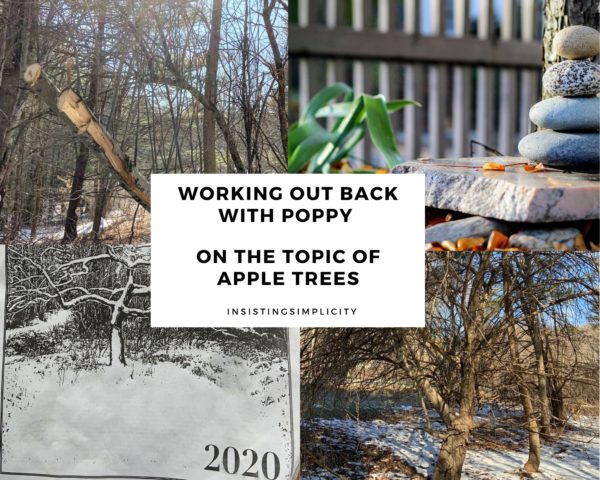
Workin' Out Back With Poppy Series
The purpose of the Workin’ Out Back With Poppy series is to showcase permaculture techniques in action. Permaculture design is experiential. We learn by doing.
We can read books and talk to experts, but to gain a deeper understanding (and appreciation) of permaculture, we must practice it.
And who’s this Poppy character anyway? Well, if and when you’re fortunate enough to become a grandparent, I understand the “what to call oneself” conversation is a big deal. When my folks became grandparents in the not-too-distant past, the names Poppy and Meme emerged, likely in jest, but they stuck.
So, Dad is now Poppy and these are the tales of workin’ out back.
On the Topic of Apple Trees
Permaculture begins with observation. Poppy is fully embracing this permaculture concept, by “observing” a group of apple trees for… about 40 years.
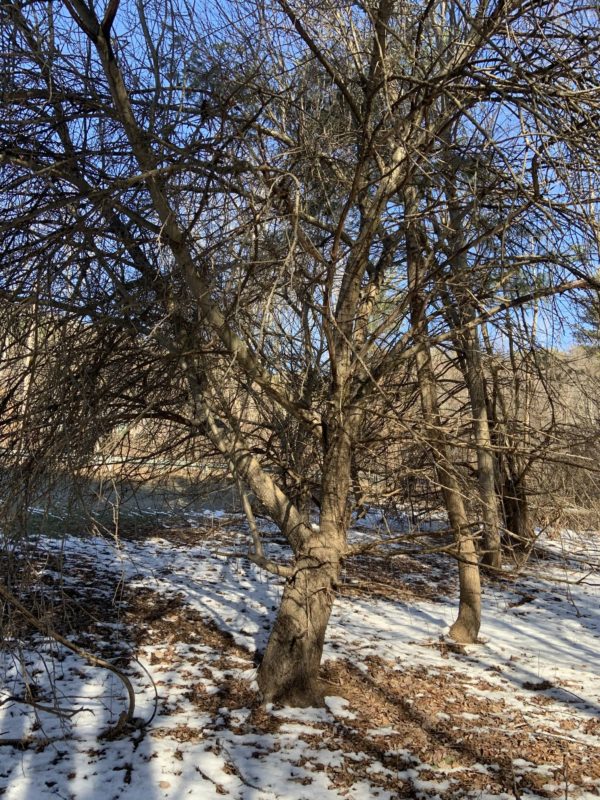
I hope you get that I’m just goofin’ here. In reality, Poppy and I rediscovered these trees and decided that maybe we should do something about them. Give ’em a haircut. See if we can’t make them producing apple trees once again. Bring them back to their full glory. Blah, blah, blah.
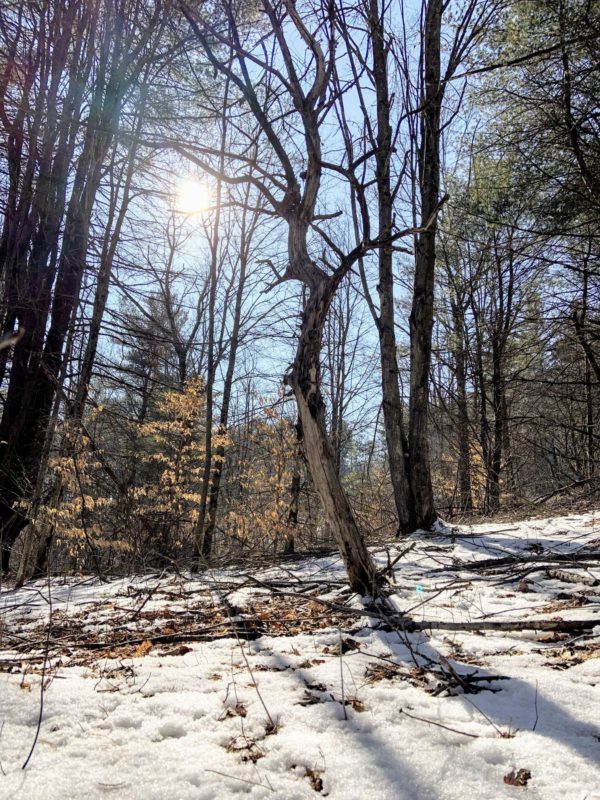
Why Do You Prune Apple Trees?
If you don’t prune an apple tree, you eventually get a tree tree. Nature will do it’s thing and it will “go nuts.”
It might stop bearing fruit. Branches will grow into the tree and entangle themselves with other branches. Limbs will die off naturally, but remain in place as hanging firewood. You might not even recognize it anymore as an apple tree and walk right by it.
It’s not the worst thing in the world… and nature will surely figure it out on your behalf, so let’s not fret too much.
But, if you’re like Poppy and me, and wish to experiment a bit, you’ll likely need to start with a pair of loppers.
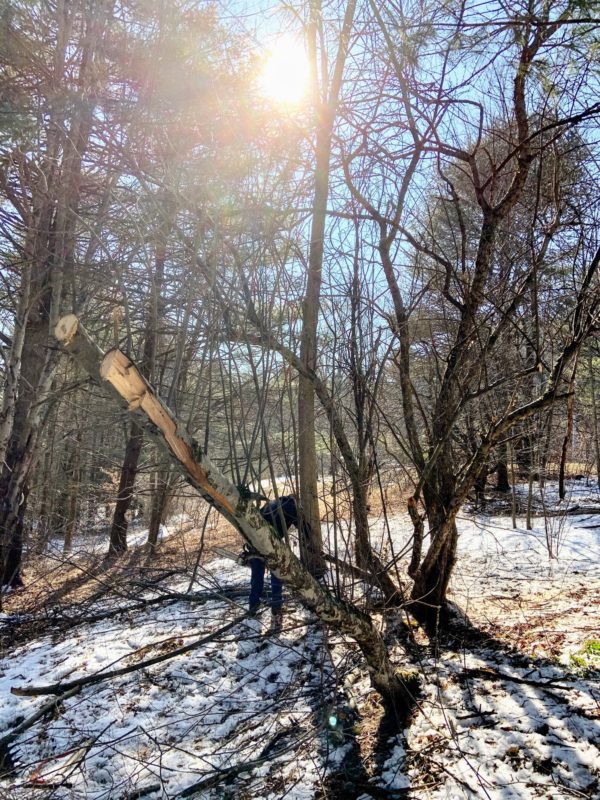
Why Prune Apple Trees in the Winter?
Late Winter is generally the best time to get your pruning done for a variety of reasons. First, if you’re working a plot that is overgrown or in the forest, winter gives you better access to the tree. High summer, you might find yourself chest deep in undergrowth or a similar prickly situation.
More importantly, the tree and other life are still dormant. Nipping off leaders and branches won’t negatively affect the tree. In fact, you’re promoting the new growth that will follow in subsequent months.
Lastly, Winter time, and February in particular, is great for burning brush. You may find yourself with a mountain of branches. The ground is still semi-frozen or frozen which holds moisture, great conditions to control burn.
Which Apple Trees Grow Best Where?
The USDA Plant Hardiness Zone Map is a great starting point for making any planting decisions, not just apple trees. Some time spent on the Department of Agriculture’s website to familiarize yourself with the conditions of your specific site is worth the effort.
You may find some surprises. For example, here in our Boston suburb, we fall in zone 7a, which corresponds to an average minimum extreme temperature of between 0 to 5 degrees fahrenheit. For Poppy, out in western Mass, his land falls within zone 5b, or -15 to -10 degrees fahrenheit. If you’ve ever had the great pleasure of driving on the Pike from Boston to Albany, you know that traversing the entire state is just couple/few hour adventure. Yet, visualizing the state from a plant hardiness zone perspective, it’s interesting to see a range from 7b (Cape Cod and islands) all the way to 5a (heart of the Berkshires).
Furthermore, make sure to spot any microclimates that may exist on your site. For example, Poppy and Meme’s property is partially wetland. This manifests in unique characteristics: temperature, humidity, moisture retention and clay-heavy soil. As we plant, transplant and do any other experiments, we will be mindful of these site-specific conditions.
Where Can I Buy Apple Trees Online?
As a disclaimer, I have no relationship with any seed providers or nurseries. I’d just like to share how I went about ordering apple trees online, as it might help you think about how to go about doing so yourself.
If I were to give advice, which is apparently what I am doing presently, I would start locally. Go find a nursery or a farm and talk to the folks running it. Sourcing plants and trees locally supports your local farmer, but also likely narrows your scope to the varieties and cultivars that are most appropriate to your region.
So, now let’s break that rule…
There are myriad online options to choose from. I chose a seed/tree provider through a vigorous, scientific process of deduction… just kidding.
My soon-to-be-through-marriage Aunt Wendy (Thank you, Aunt Wendy!) gave me a gift certificate to FEDCO over the holidays as a secret Santa gift. Aunt Wendy is a green thumb and bird lover, so I trust her endorsement.
As I leafed through the FEDCO catalog, I was not disappointed. I knew I stumbled upon a gem…
Planning Out Your Order
Before you mentally design a sprawling apple orchard, you may want to ground thyself in reality.
“Hey, honey. I’m gonna order like 50 apple trees and plant an orchard out back, cool?”
“Ahhhhh, what?”
Yeah, avoid that one.
Start small, try something funky.
My solution: “I’ll keep it under a hundy, honey.”
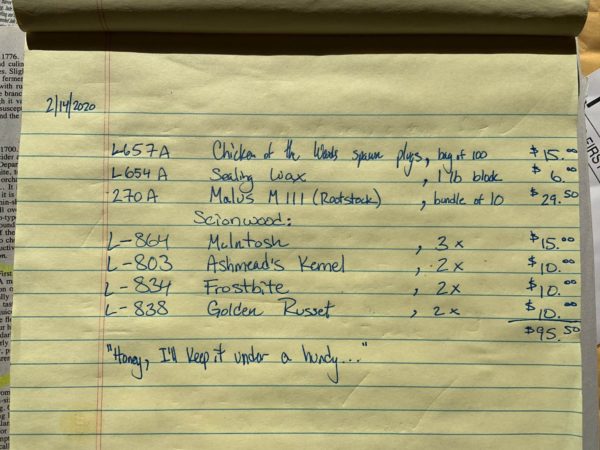
I put thought into this order, but I didn’t want to overthink it. Let’s have some fun and experiment, right?!
I knew I wanted McIntosh. Why? Because I…LOVE…McIntosh apples. That’s why.
Also, according to FEDCO, the McIntosh “…beginning in about 1930, (was) the most important apple in the Northeast until Honeycrisp appeared.” My experience supports this claim. I’d be shocked to go to a New England apple orchard and not find McIntosh. McIntosh is a Fall season tree.
Ashmead’s Kernel is a high flavor fruit, stores well and “… (makes) a good sharp addition to hard cider.” This is a winter season tree.
Frostbite is a Fall-Winter season apple with a distinct and complex flavor. FEDCO explains, “Astonished eaters have described it as tasting like molasses, olives, sugar cane, cheap whisky, yogurt, tobacco juice, and so on. We love it.” Weird! I don’t think I’ve ever had one before, so I’m really excited to see what they’re like (years from now when they are ready to fruit, of course).
Golden Russet is a Winter tree, great for fresh eating, storing and making cider. Described by FEDCO as the “champagne of cider apples.” Nice!
So, there you have it, two varieties of Fall and two varieties of Winter trees. I deliberately chose a diversity of fruit characteristics, so that we could potentially utilize them in different ways, i.e. fresh eating, drying, cooking, cider, etc.
Discerning eyes will notice the “rootstock” and “scion” wood details of the order.
This means… grafting! Stay tuned!
Oh, and don’t overlook the mushroom plugs, more on that another time!
Conclusion and Next Steps...
I hope you enjoyed this piece on apple trees. They are incredibly important to the New Englander and an essential part of our future permaculture inspired landscape. Tune in next time for more permaculture projects!
What are you prepping for Spring?


Cant wait to see what comes of the old tree this spring, summer and fall!
We shall see. Everyone feels better after a lil’ trim!